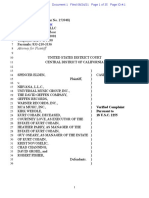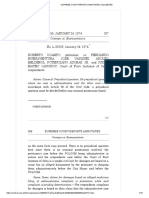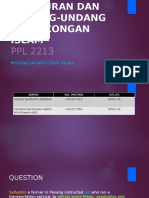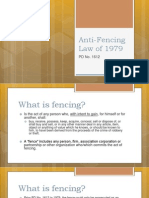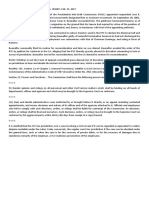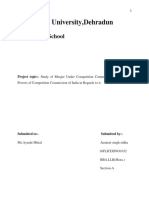Chapter Causation and Remoteness of DamageRevision Aid1. Definition
This is the third element of the tort of negligence.The claimant must show that the defendant’s breach of duty caused the harm and/or loss.
2. Factual Causation
The defendant’s breach of duty must cause the damage or materially contribute to the damage.The courts use the ‘but for’ test to establish factual causation.
Cork v Kirby Maclean Ltd:
this case described the test and stated that if the damage would nothave happened but for a particular fault then that fault is the cause of the damage.
Barnett v Chelsea and Kensington Hospital Management Committee:
the hospital was able toshow that even if the claimant’s husband had been examined with proper care he would stillhave died and the defendant’s breach was not the cause of the death.Sometimes it is difficult to apply the ‘but for’ test.
Chester v Afshar:
the court said that in this case it was difficult to prove causation using the ‘butfor’ test and that policy considerations required a judge to decide whether justice demandedthat the usual approach to causation should be modified. The court in this case held thatcausation had been proven on policy grounds and the claimant won.It must be remembered that the judges in
Chester
made it clear that the case was unusual andwas decided on its own particular facts.
3. Loss of Chance Cases and the ‘But For’ Test
These are usually cases of medical negligence.In these cases the claimant claims that they had a certain percentage of chance of being curedbut that percentage was reduced because of the doctor’s delay.The courts have to decide if it can be said that the delay by the doctor caused the patient to notbe cured or whether the claimant would not have been cured regardless of what the doctor did.Generally the courts are not willing to award compensation.

Hotson v East Berkshire Area Health Authority:
the defendant’s negligently failed to diagnosethe claimant’s hip condition. Expert medical testimony indicated that had his fractured hip beenidentified on his initial hospital visit, there was a 25% chance of his condition having beensuccessfully treated (and thus a 75% chance it would have made no difference). The House of Lords held that the claimant had not satisfied the burden of proof and was not entitled todamages.
Greg v Scott:
whilst the defendant had been negligent in his original assessment, it remainedthat loss of a chance was not a form of injury for which one could claim damages for tortiousnegligence in relation to medical problems.
4. Several Concurrent Causes of Harm
The courts have modified the ‘but for’ test where there is more than one cause of damage.
(a) Material Increase of Harm:
Bonnington Castings Ltd v Wardlaw:
there were two potential causes of the claimant’s illness –the guilty dust that should not have been present in the working environment and the innocentdust that would have been present anyway.The House of Lords held that the claimant had to show that the guilty dust materiallycontributed to the illness and not that it was the only cause of the illness.
Sienkiewicz v Greif:
the court held that where there is more than one possible cause of theinjury, causation can be proved if the claimant can show that the defendant’s negligencematerially increased the risk of injury.
McGhee v NCB:
one possible cause of the claimant’s skin disease was exposure to brick dustand the other was failure to provide washing facilities. The court held that causation could beproved if the claimant could show that the defendant’s negligence materially increased the riskof injury.
Bailey v Ministry of Defence:
the Court of Appeal decided in favour of the claimant stating thatthe defendant’s negligence materially contributed to what had happened.
(b) Material Cause of Injury:
When using this modification of the ‘but for’ test, it is not enough to show that the defendantmerely increased the risk of damage. The claimant must show that the defendant’s negligencewas a material cause of the injury.
Wilsher v Essex Area Health Authority:
on the facts the defendant’s negligence was only one of the possible causes but not the material cause of the injury and this the defendant was not heldliable.
5. Consecutive Causes of Harm
Where there are two independent events the second event causes the same injury as the onecaused by the first event then the first event shall be treated as the cause.
Baker v Willoughby:
the defendant in this case was liable for the full extent of the claimant’sinjury which also included being shot in the same leg that was injured by the defendant’snegligence.
Jobling v Associated Dairies:
in this case the defendant was not liable for the full extent of thedefendant’s injury as the subsequent spinal disease was brought on by natural causes.
Fitzgerald v Lane:
both drivers were held liable for all the injuries as it could not be shownwhich impact caused the claimant’s harm.
Performance Cars Ltd v Abraham:
the first defendant was held responsible for the entireamount due as regards the damage to the car. The second defendant was absolved from payinganything.
6. Multiple Tortfeasors
This is where there is more than one defendant who could be responsible for the harm in wholeor in part.
Holtby v Brigham and Cowan:
the claimant suffered from asbestosis. He had been employed bythe defendant for half the time of his work life and other companies for the rest of that time.The defendants were held liable as their negligence had made a material contribution to theclaimant’s harm. Liability was assessed at 75%.This principle can work harshly against the claimant as he would not be able to recovercompensation in full.
Fairchild v Glenhaven Funeral Services:
this problem was partially corrected in this case. Theclaimant suffered from mesothelioma. He had been exposed to asbestos fibres duringemployment with several different employers. Some of them had gone out of business andcould not be sued. The remaining defendants denied liability on the basis that it could not beproven that their asbestos was what the claimant inhaled.
The House of Lords extended McGhee and stated that each defendant’s breach materiallyincreased the risk of contracting mesothelioma and the claimant was entitled to compensationin full.The defendants did not see this decision as fair as they had to pay compensation even if theywere not to blame for the harm.
Barker v Corus:
Fairchild was applied and the claimant was successful but damages werereduced by 20% to take into account the period the claimant was self-employed and exposedhimself to asbestos.Baker partially overruled Fairchild in that liability was several rather than joint. This meant thatthe defendant would be liable to the extent to which their negligence exposed the claimant tothe risk of mesothelioma.This position was criticized and the government in power at the time introduced legislation torestore the Fairchild principle.Section 3(1) of the Compensation Act 2006 states that causation can be proven by showing thatthe exposure to asbestos made a material contribution to the risk of contracting mesothelioma.
Sienkiewicz v Greif:
the Supreme Court held that the Fairchild principle was developed formesothelioma cases and the principle will apply regardless of whether there is single ormultiple exposure. As far as what constitutes material increase it was held that this wassomething for the judges to decide on the facts of the case.
7. Intervening Acts
If the defendant can show that the chain of causation is broken by an intervening act then hewill not be liable. This is also known as novus actus interveniens.There are two types.
(a) Intervention by the claimant:
McKew v Holland:
if the injured person acts unreasonably he cannot hold the defendant liablefor injury caused by his own unreasonable conduct.
Wieland v Cyril Lord Carpets:
the defendant in this case was liable for the full extent of theclaimant’s injuries as she had not acted unreasonably and did not break the chain of causation.Not all irresponsible behavior will break the chain of causation.




























































